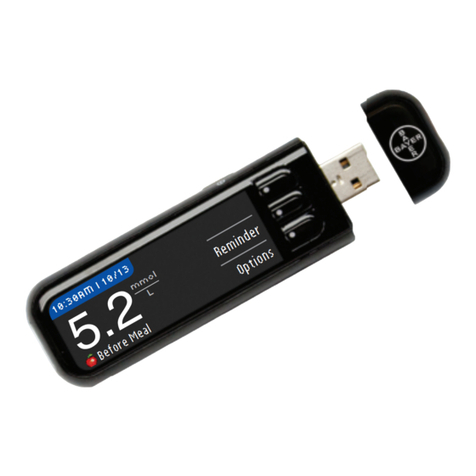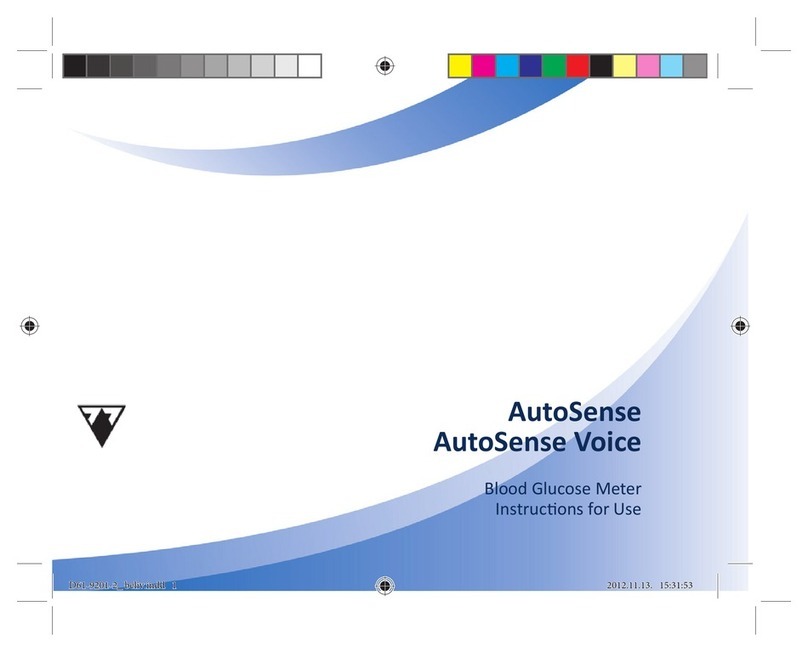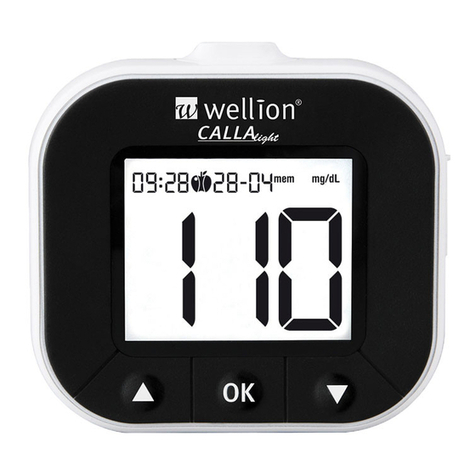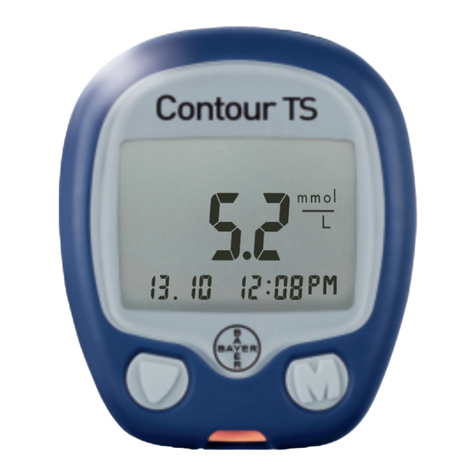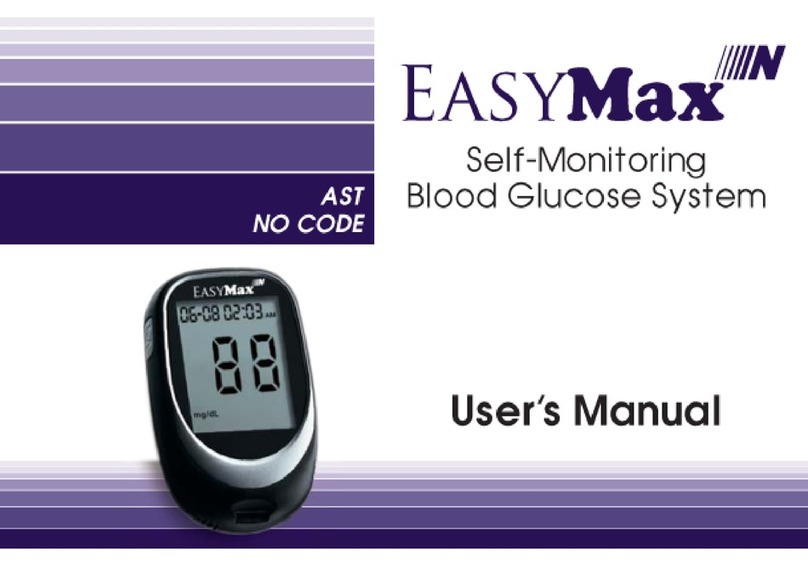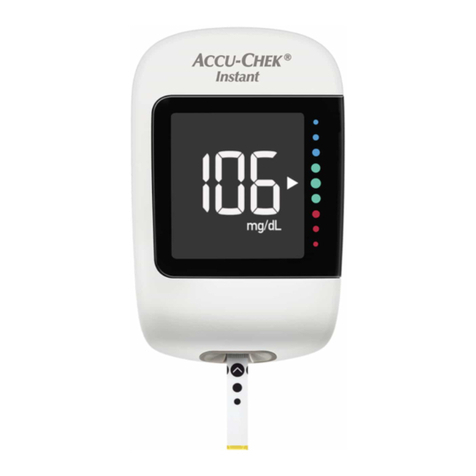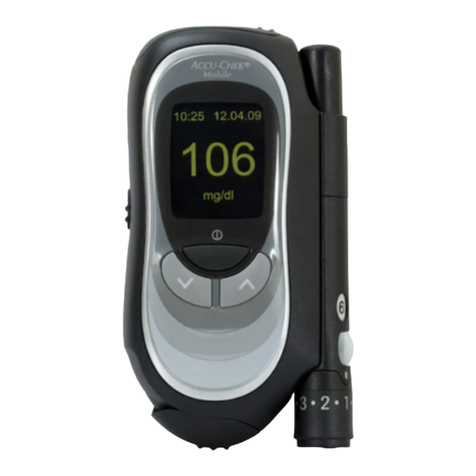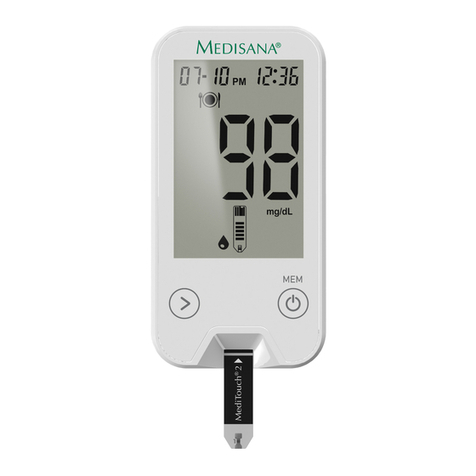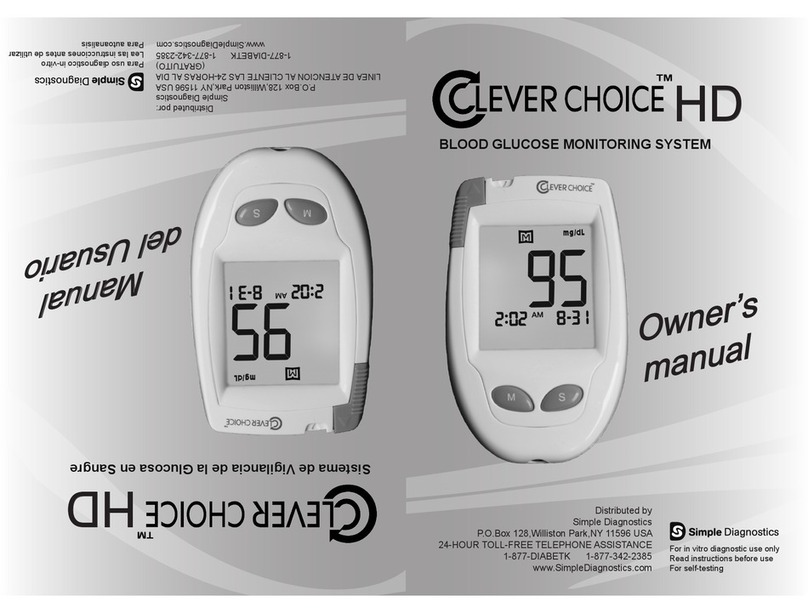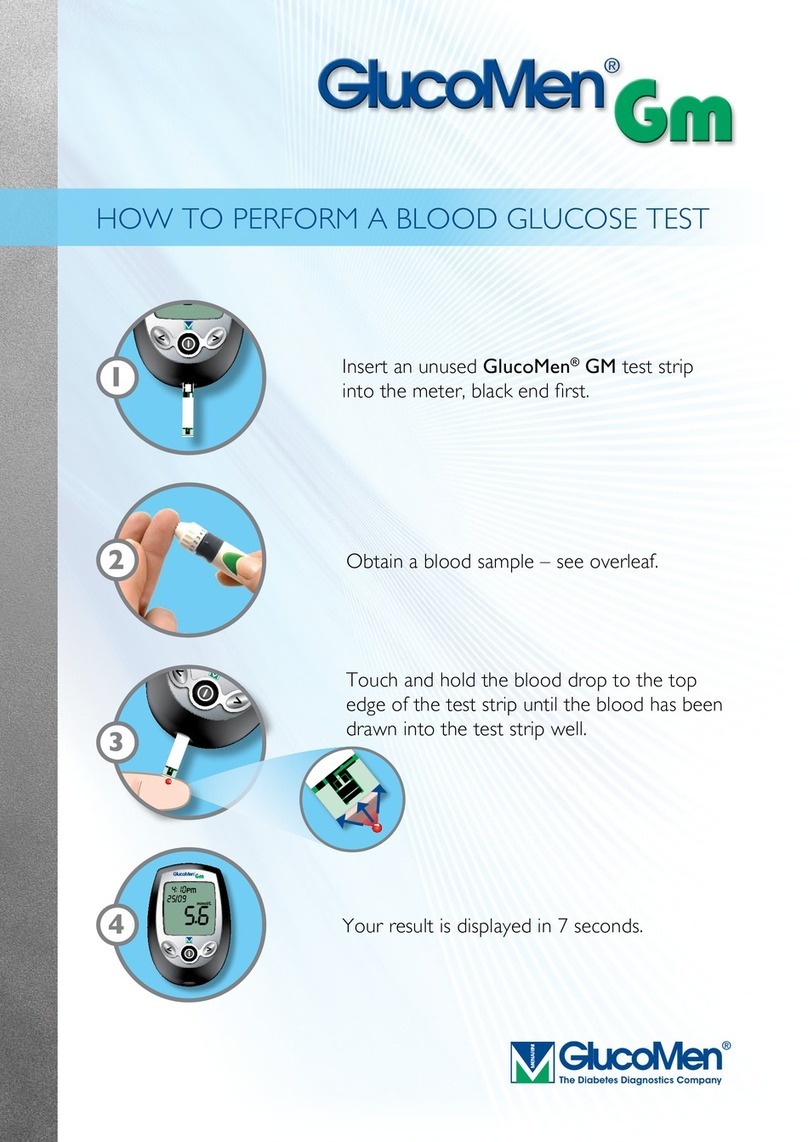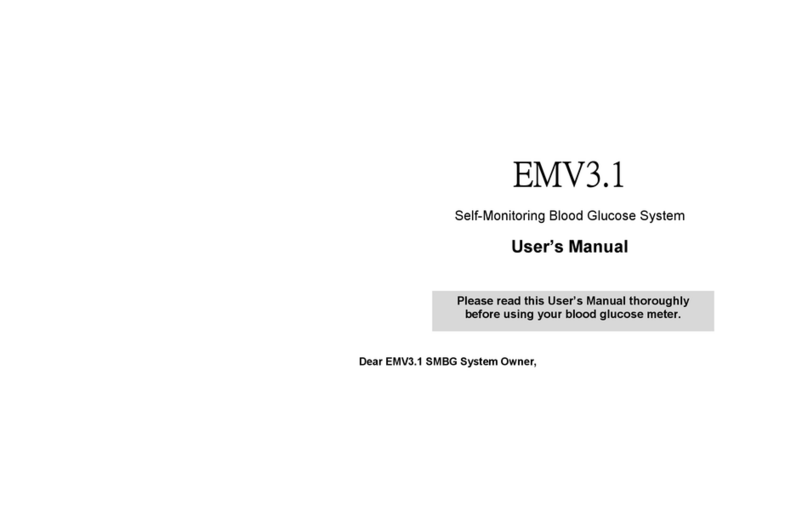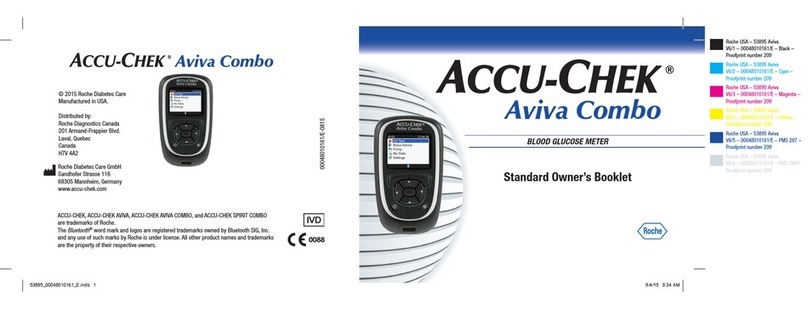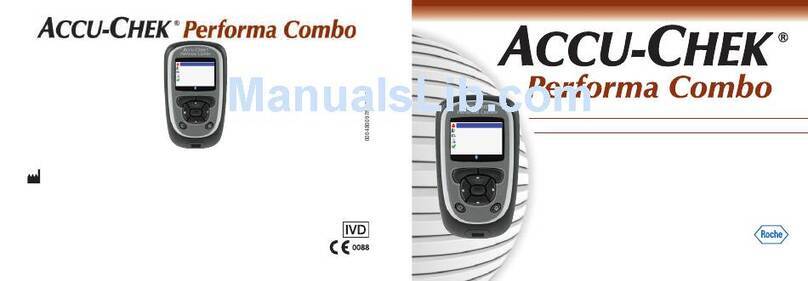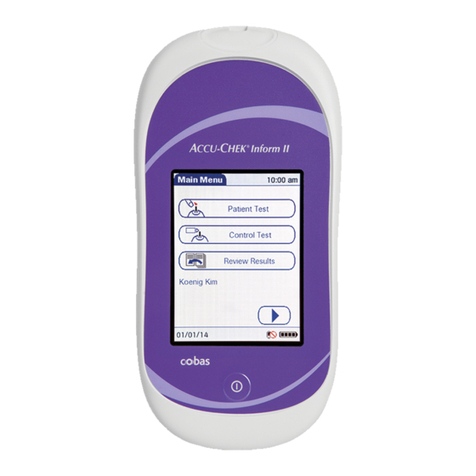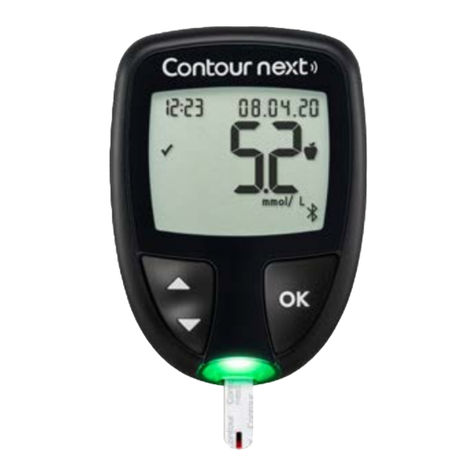INFINOVO MEDICAL p3 User manual

Continuous Glucose Monitoring
Systems
Transmitter, Sensor, App
USER MANUAL
Model:p3
INFINOVO MEDICAL CO.,LTD.
JN-STP-P3-SMS-001
version no. V01
effective date: 2022.06.01

Table of Contents
Terminology .................................................................................................................. 1
1 Product overview ........................................................................................................ 2
1.1 Sensor overview ................................................................................................3
1.2 Transmitter overview ........................................................................................4
1.3 App overview ....................................................................................................4
1.4 Analysis Software overview ............................................................................. 5
2 Safety Information ...................................................................................................... 8
2.1 Application definition .......................................................................................8
2.2 Important user information ............................................................................... 8
2.3 Contraindications ..............................................................................................8
2.4 Warning ............................................................................................................ 8
2.5 Precautions ......................................................................................................10
3 Risk and Efficacy ......................................................................................................12
3.1 Risk ................................................................................................................. 12
3.2 Efficacy ...........................................................................................................12
4 Installation and Use .................................................................................................. 13
4.1 Installation ...................................................................................................... 13
4.2 Use .................................................................................................................. 16
4.3 End session and remove sensor ...................................................................... 18
4.4 Calibration ...................................................................................................... 19
5 App interface introduction and function application ................................................ 22
5.1 Main interface .................................................................................................22
5.2 Function Bar ................................................................................................... 24
5.3 Alarm/Alert .....................................................................................................25
6 Faults and Troubleshooting ...................................................................................... 28
7 Maintenance ..............................................................................................................29
8 Travel information .................................................................................................... 30
9 EMC Statement .........................................................................................................31
10 User help .................................................................................................................34
11 The warranty ...........................................................................................................35
11.1 The scope and duration of warranty ............................................................. 35
11.2 The following conditions are not in the scope of warranty .......................... 35
11.3 Warranty liability ..........................................................................................35
11.4 Warranty Statement ...................................................................................... 35
12 Label symbol and graphic description ....................................................................36
13 Date of manufacture ............................................................................................... 37
Appendix ......................................................................................................................38

1
Terminology
Sensor
Component of the monitoring system, including the applicator,
sensor electrode and sensor base. The applicator inserts the
sensor electrode under the skin to measure blood glucose level
in interstitial fluids.
CGM
Abbreviation for Continuous Glucose Monitoring
CGMS
Abbreviation for Continuous Glucose Monitoring Systems
Applicator
A disposable product that inserts the sensor electrode under the
skin and will be removed after the sensor electrode is inserted.
Sensor
electrode
A device inserted under the skin that reacts with the interstitial
fluid and converts biological signals into electrical signals.
Sensor base
A small plastic base attached to the abdomen to hold the
transmitter.
Releaser
A plastic part, used for removing the transmitter from the sensor
base.
Transmitter
The Transmitter is a component of the Continuous Glucose
Monitoring system, which is applied in the sensor base and
sends the blood glucose information to the Mobile Application
wirelessly via Bluetooth Low Energy.
Transmitter
serial number
Consisting of numbers and letters, it is unique for each
transmitter and can be found on the back of the transmitter
App
The mobile software that receives blood glucose information,
displays blood glucose readings, trend curves, trend arrows and
transmitter status.
Default value
The values that come with the system.
Sensor Code
Calibration code of the sensor
Calibration
Blood glucose value measured by the blood glucose meter and
entered into the App for calibration to ensure the accuracy of the
blood glucose reading.
Blood Sugar
value
Values measured by blood glucose meter.
Sensor Glucose
readings
Values measured by Continuous Glucose Monitoring Systems
Trend curve
Displays changes and tendencies in blood glucose over a period
of time and current blood glucose status.
Trend arrow
Indicate the speed of change in blood glucose levels.
Data receiving
range
The communication distance between the App and the
transmitter, which shall be within 2 m without obstacle.
Repeat prompt
When the first notification is not confirmed, the prompt will be
repeated.

2
1 Product overview
The Continuous Glucose Monitoring Systems consists of a disposable Sensor,
Transmitter, Mobile Application,and Analysis Software, in which the core device is
the sensor. It is recommended to wear the sensor on the abdomen and avoid
movement where the sensor is applied. The sensor electrode chemically reacts with
glucose in the hypodermic interstitial fluid to generate an electrical signal.
Transmitter analyzes and calculates the electrical signal, and generates the blood
glucose values, which is sent to the mobile App. The user analysis software
downloads and collects data from the mobile App for processing and analysis, then
gives reports.
Continuous Glucose Monitoring Systems (p3) can display glucose readings
automatically after when entered Sensor code at starting CGM. The CGMS
measures a glucose reading every three minutes, making 480 readings in total each
day. The system can continuously monitor the blood glucose data for 14 days and
form a continuous blood glucose curve. In addition, dining, sport, medication and
other activities can be recorded as an event.
Continuous Glucose Monitoring System

3
1.1 Sensor overview
Safety lock
Button
Sensor base and
Adhesive patch
Sensor
The continuous glucose monitoring sensor is a product with a sterile sealed pouch.
The sensor is mainly made up of an applicator, a sensor base and a sensor electrode.
The base consists of a PC base and an adhesive patch. Insert the sensor electrode
into the subcutaneous tissue of the abdomen and remove the applicator. The base is
attached to the abdomen for up to 14 days of monitoring. Please discard disposable
sensor after wearing.
The performance parameters of sensor
Model No.
SP3-WL-03
Measurement range
2.2-22.2 mmol/L
Effective working time
14 days
Calibration method
Factory calibration
Calibration range
2.2-22.2 mmol/L
Storage conditions
Temperature:2oC-25 oC;
Relative humidity:15%-85%
Transport conditions
Room temperature for transportation
Rated voltage
d.c. 3V
Working conditions (After
the transmitter placed in the
sensor base)
Temperature:10 oC-40 oC;
Relative humidity:10%-95%
Battery lifetime
No less than 14 days
Sterilization method
Irradiation sterilization
Validity period
Details see the product label

4
Power support
Internal power supply
1.2 Transmitter overview
The continuous glucose monitoring transmitter is a component connected to the
sensor base with chips. Once the transmitter is fixed in the sensor base and the
sensor electrode is activated through the App, the transmitter sends the sensor
glucose value to the App. When properly worn, the Transmitter and App have a
transmission range of 2 m without obstruction. Wireless connection in swimming
pools, bathtubs and waterbed might be impaired.
The performance parameters of transmitter
Model No.
TP3-WL -03
Size
length33.1 mm *width19.35 mm *height 8.8mm
Weight
4.0 g
Display interval
3 mins
Data receiving range
2 m(without obstruction)
Expect product service life
Reused up to 10 times
Validity period
36 months
Operation mode
Continuous performance
Protection grade
IP27
Working conditions (After
the transmitter placed in the
sensor base)
Temperature:10 oC-40 oC;
Relative humidity:10%-95%
Atmospheric pressure
70kPa-106 kPa
Transport and Storage
conditions
Temperature:0oC-45 oC;
Relative humidity:10%-95%
Wireless
Bluetooth5.0, 2402-2480 MHz, GFSK, 0.65dBm
1.3 App overview
The App is a mobile medical application for its continuous glucose monitoring
system to receive and process glucose readings. The software displays blood
glucose readings, trend curves, trend arrows, and transmitter status. It has functions
of adding Notes, Alarms/Alerts, Logbook Entries, Reports, Data Export feature and
so on.

5
Main interface of App
The main interface of App mainly displays blood glucose readings, trend curves and
trend arrows. App and transmitter can be connected through Bluetooth, pairing for
data communication. A blood glucose meter is also needed to use the Continuous
Glucose Monitoring System.
The performance parameters of App
Item
Detail
Operating system
Android 6.0 and above/IOS 13.2 and above
Connection
One App can only connect to one transmitter at
the same time
Data transmission
Transmitter and App (phone) transmit data via
Bluetooth protocol
The file exported by the app is transferred to
the analysis software via wireless or USB data
cable (Only Android)
Storage Format
App export data storage format is Excel file
1.4 Analysis Software overview
Analysis software downloads and collects data from the Mobile App for processing
and analysis, then produces reports.

6
Warning:
The software does not provide any medical advice and cannot be used for such
purpose. Do not adjust your treatment plan without consulting your medical
diabetes team.

7
The performance parameters of Analysis Software
Item
Detail
Operating system
Windows 7 and above
Tip: Software works on both 64-bit and 32-bit
systems.
Data transmission
The file exported by the app is transferred to
the analysis software via wireless or USB data
cable (Android Only)
Report Format
Export format is PDF file

8
2 Safety Information
2.1 Application definition
The device is intended for continuous or periodic recording of glucose levels in
interstitial fluid for patients with diabetes aged 2 or older. The information is
intended to support, rather than to replace standard glucose monitor and is intended
for detecting trends and track pattern to provide reference information for patients to
better manage diabetes. The system provides real-time blood glucose value, which
is received and read by the App. The blood glucose value data can be further
imported into the software for analyzing historical blood glucose values.
Apply site:
Abdomen
Frequency of data interaction:
Once every 3mins
Reuse:
Sensor is disposable;The transmitter can be reused up to 10 times.
Warning:
CGMS(p3) does not provide any medical advice and cannot be used for such
purpose. Do not adjust your treatment plan without discussing it with your
medical diabetes team.
2.2 Important user information
In order to use this product safely, please review your product instructions before
using your Continuous Glucose Monitoring System. The instructions include
contraindications, warnings, cautions, and other important user information. Discuss
with your doctor how to use the information to help you control your blood glucose.
The instruction manual contains important information about system
troubleshooting and equipment performance characteristics.
2.3 Contraindications
Part of the sensor shall pierce the skin, so it is recommended that people with
delicate skin use the device cautiously. The product must be removed before you
undergo magnetic resonance imaging (MRI).
Intake of acetaminophen while wearing the sensor may falsely raise your sensor
glucose readings.
2.4 Warning
Read the instructions thoroughly. incorrect use of the continuous blood glucose
monitoring system may lead to misunderstanding of the information provided
by the system or affect the performance of the system and miss the low/high

9
blood glucose incidents.
Continuous blood glucose testing cannot be used as a basis for diabetes
diagnosis, such as for insulin injection treatment. It cannot replace blood
glucose meter. The value of blood glucose may differ from the reading of blood
glucose. Using glycemic readings as a diagnostic basis for diabetes may result
in low/high blood glucose.
Do not ignore the symptoms of high / low blood glucose levels. If the sensor
glucose reading does not match the symptoms, the blood glucose meter should
be used to measure the blood glucose even if the reading is within the normal
range.
There is no need to calibrate after Sensor code be entered. If the user wants to
calibrate, he can still enter finger blood calibration. Calibrate at least once every
24 hours if no Sensor code is entered, otherwise the sensor glucose readings
might be inaccurate and you might miss a low or high blood glucose value.
In rare cases, the sensor electrode may fracture. If the sensor electrode breaks
and there is no visible sensor electrode on the skin, do not attempt to remove it
yourself. Seek professional medical help in the condition of infection or
inflammation - redness, swelling or pain. If the sensor electrode ruptures, please
report to our technical support department.
Do not use sensors when its sterile packaging is damaged. Using unsterilized
sensors may lead to infection.
The storage temperature of the sensor is 2oC-25oC. The sensor can be
transported at room temperature. The storage time is the lifetime of the sensor.
If the temperature range of the refrigerator is 2oC-25oC, the sensor can be stored
in the refrigerator. Improper storage results in inaccurate blood glucose readings
and missing low/high blood glucose levels. If the sensor is stored in the
refrigerator, please take it out half an hour before use. The sensor can be used at
room temperature.
The device is not designed to remain in the body long-term, or to be replaced
‘immediately’ with a similar or identical device.
Your transmitter communicates with your App via Bluetooth. The
communication might be affected by strong electro-magnetic field, keep your
CGMS away from any strong electro-magnetic field. Otherwise, degradation of
the performance of this equipment could result in malfunctioning of the system.
With the prompt function off, the App cannot give a prompt (notification) even
if the Transmitter and the App are within communication range.
Symptoms that may be caused by high/low blood glucose should not be ignored.
If the symptoms you are experiencing do not match the CGMS readings, or you
suspect that the CGMS readings may be inaccurate, check the glucose by
performing a fingerstick blood test using a blood glucose meter.
When CGMS shows that your glucose level is low or near the low limit,
perform a fingerstick blood test using a blood glucose meter.
The CGMS contains small parts that may cause choking if swallowed, keep

10
them away from the reach of children.
2.5 Precautions
The sensors and transmitters of the CGMS should be matched. The products of
different generations cannot be connected and cannot work. Make sure that the
system uses the correct software version.
Before opening the sensor package, wash your hands with soap and water and
dry them.
Before inserting the sensor, clean the skin with alcohol tablets and let it dry up.
This helps prevent infection. Do not insert the sensor until the skin is dry so that
the tape on the sensor base can be better attached to the skin.
Change the insertion site each time. Using the same insertion site too often may
not allow the skin to heal, and may cause scars or skin allergies.
It is forbidden to insert sensors in areas that may be bent, squeezed, tattooed, or
allergic. These sites are not ideal for measuring blood glucose. Inserting sensors
in these places may affect the performance, missing low/high blood glucose
values.
It is forbidden to insert sensors within 8 cm of insulin injection and placement
of insulin pump. Insulin may affect the performance of the sensor, missing
low/high blood glucose levels.
To calibrate the system, enter the exact blood glucose value measured by the
glucometer within 3minutes. Inaccurate input or input exceeding 3minutes may
affect the performance of the sensor and result in missing low/high blood
glucose values.
Rapid changes in blood sugar can affect the accuracy of the system, such as
during exercise or after meals.
When properly worn, the transmitter and App have a transmission range of 2 m
without obstruction. Wireless connection in the water is not very well, so the
range of connections in places like swimming pools, bathtubs and waterbeds
will be reduced. There are no tests for different types of obstruction. If the
distance between the transmitter and App is more than 2 m or if the distance
between them is blocked by an obstruction, they may not be connected or the
connection distance may be shorter. You may miss the low/high blood glucose
level. Yet all the data will still be stored in your transmitter, so your App is able
to display all the data when there is good communication again.
The transmitter can be reused up to 10 times in its lifetime, so do not discard it.
In rare cases, the sensor may give inaccurate glucose readings. If the glucose
reading is believed to be incorrect or inconsistent with symptoms, perform a
fingertip glucose test and check to ensure that the sensor is not loose.
Intense exercise may cause the sensor to be detached or loosened. If the Sensor
is loose, you may not get a reading or the reading may not be reliable and may
not match how you feel. Follow instructions on selecting the appropriate site for

11
application.
Severe dehydration or excessive water loss may result in inaccurate CGMS
readings.
On rare occasions, patients may experience mild skin redness and swelling on
the insertion site.

12
3 Risk and Efficacy
3.1 Risk
Inserting sensors and wearing adhesive tapes are less likely to cause infection,
bleeding, pain or skin irritation (redness, swelling, bruising, itching, scarring or
discoloration). In the clinical studies, a small number of patients experience mild
skin redness and swelling. If these symptoms occur, the patient may feel
uncomfortable at the location where the sensor inserted.
In rare cases, the sensor electrode may break and remain in the body. This
phenomenon did not appear in the clinical study. If you feel the sensor is broken
inside your skin, contact your medical diabetes team and technical support.
When the prompt function is turned off or the transmitter and App are not within the
communication range, the prompt cannot be obtained.
When you cannot hear the tone or feel the vibration, you may not notice the prompt.
Sometimes the sensor glucose readings may be slightly different from the values
measured by blood glucose meter. In most cases, the sensor glucose reading moves
with the blood glucose level and prompts after the glucose level exceeds the target
range.
If you are at high/low blood glucose levels, but you are not prompted, you will not
test your blood glucose with blood glucose meter, and you will miss high/low blood
glucose values.
3.2 Efficacy
The Continuous Glucose Monitoring Systems provides more effective and
comprehensive information than the blood glucose meter. In 14-day monitoring, the
continuous blood glucose monitoring system provides a blood glucose reading every
three minutes to help you observe the trend of blood glucose changes. Dynamic
information can help you check the current blood glucose status, as well as the
direction and speed of changes in blood glucose. Recognizing trends in blood sugar
can help you take steps to avoid high/low blood sugar levels.
App alerts when blood glucose levels exceed your target blood glucose range or
when blood glucose drops or rises rapidly. The alerts can remind you to take
measures to avoid low/high blood sugar.

13
4 Installation and Use
This chapter describes how to use your p3 systems, please read carefully before use,
and follow the indication step-by-step.
4.1 Installation
4.1.1 App installation and setting
a) Download App from Google Play / App Store;
b) After installed, please complete personal information.
c) Setting your target and Alarm/Alert Sound type.
d) Units of measurement:Select Glucose unit mmol/L or mg/dL.
4.1.2 Prerequisites
Turn on the Bluetooth of the mobile phone and keep the phone within 2 meters of
the Transmitter in an accessible state. Allow the App to access your smart device
location for Android system.
4.1.3 Sensor Insertion
1)Prepping
a) Do NOT use if the sensor package seems to be damaged or is already opened.
b) Do NOT use after the sensor expiry date.
c) Wash your hands
d) Clean bottom of transmitter with alcohol wipe;
e) Let the transmitter dry.
Note:Be careful, don’t touch its metal dots and scratch it (that may damage the
water resistant seal).
2)Insertion site
a) Only on the Abdomen;
b) 5 cm away from the belly button;
c) 5 cm away from the insulin Injection site;
d) Avoid position where it can be pressed when you are wearing a belt;
e) Avoid fatty induration site
Note
:
Change insertion site after previous use
Clean the skin condition before insertion
Check whether package is broken

14
Check expiration date before insertion
Insertion site
3)Clean insertion site
a) Clean the insertion site with an alcohol wipe and allow it to dry before
proceeding.
b) Make sure area is clean and free of lotions, perfumes, and medications.
4)Apply Sensor
Remove the protective liners from the bottom of
the sensor base, and don't touch the adhesive tape.
Place sensor horizontally on the abdomen;
Press the applicator to ensure that the tape is firmly
attached on the skin.
Hold the applicator and pull the Safety Lock to
unlock mode.

15
Press the top button of the applicator, and the
sensor electrode have been inserted automatically;
Gently pull applicator up until you see adhesive
patch.
Ensure the tape firmly bonded.
Run your fingers around the adhesive.
Slide transmitter tab into the slot at the end of the
holder.
Press the other end of the transmitter until it clicks
into the holder, you will heard 2-clicks sound.
If the transmitter isn’t embedded properly,it may
cause the transmitter to break away.
Warning
The sensors (Model No. SP3-WL-03 )and transmitters (Model No.
TP3-WL-03)of the Continuous Glucose Monitoring Systems(p3)should be
suitable for each other. The products of different generations cannot be
connected to each other and thus cannot work. Make sure that the system uses

16
the correct Glunovo software version.
4.2 Use
4.2.1 Pairing Transmitter
Enter Transmitter SN and PIN Code to start pairing.
Note: For problems in pairing, check
<Troubleshooting>.
Enter sensor LOT number and Sensor Code to “Start
CGM”.

17
Warm up time: 120 Mins.
Note: No High/Low Alarm during warming up; Keep
the connection between transmitter and phone during
warming up.
1st calibration happens after warm up if not entered
Sensor code when starting CGM. After that enter
calibration once every 24 hours;
If entered Sensor Code, this is not necessary.
Note: Do calibration before meal.
4.2.2 Blood glucose readings and curve
Blood glucose readings and trend curve are shown in App’s Home Screen.

18
Home Screen
Caution
Continuous blood glucose testing cannot be used as a basis for diabetes
diagnosis, such as insulin injection. It cannot replace the blood glucose meter.
The value of blood glucose may not be consistent with the reading of blood
glucose. Using glycemic readings as a diagnostic basis for diabetes may result
in low/high blood glucose.
4.3 End session and remove sensor
Settings→EXPORT NOW
Note: After 14 days’ monitoring, CGMS will be
stopped automatically, also can be removed manually.
Settings→Device Information→Remove Current
Device
Note: After the sensor is ended
,
the App will not
receive BG readings and Alarm/Alert.
Note:Data for this session will be reserved for future
export
Take off adhesive patch.
Note: Remove sensor and transmitter together.
Table of contents
Other INFINOVO MEDICAL Blood Glucose Meter manuals



